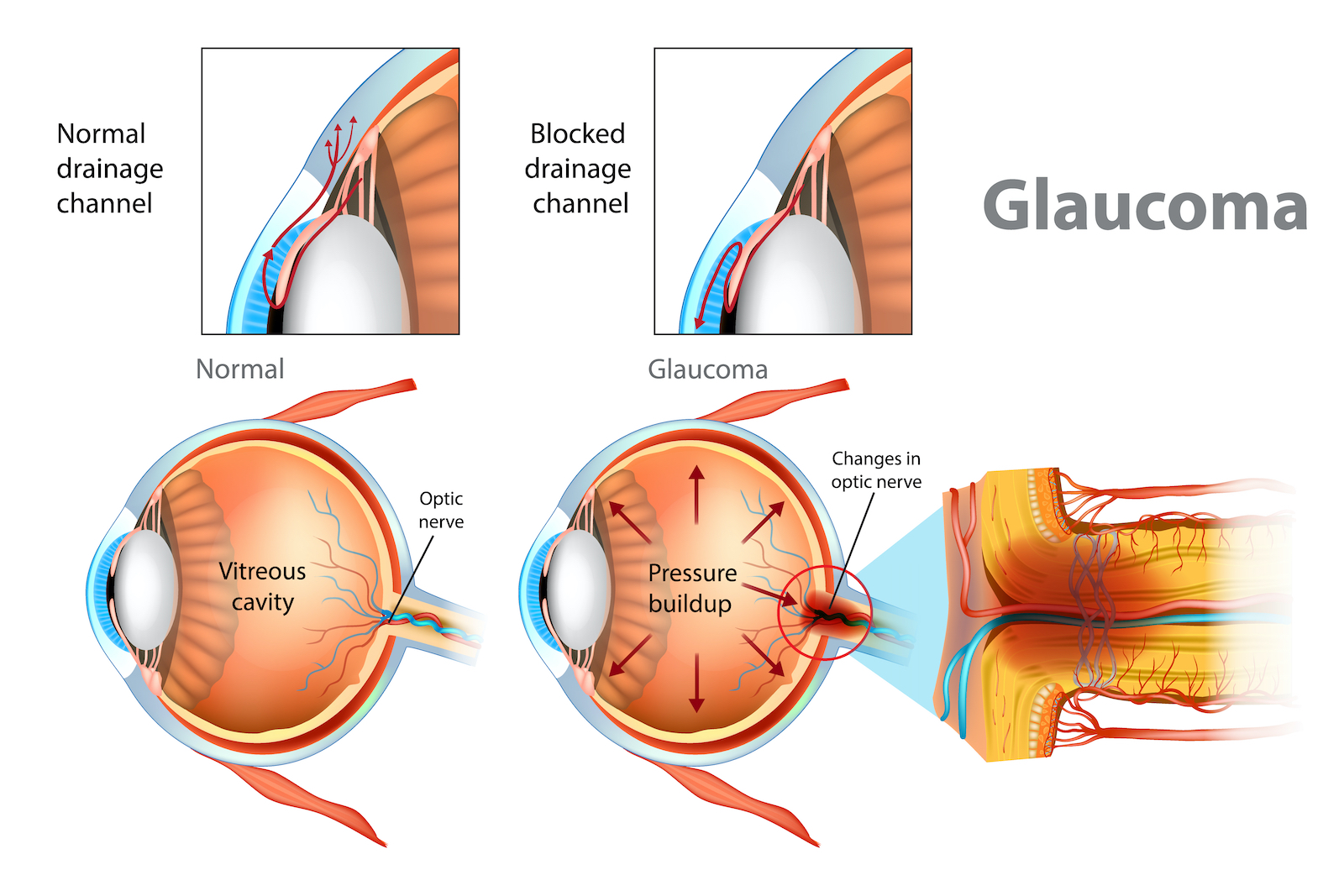Glaucoma

Glaucoma is an eye condition that causes gradual loss of vision if left untreated. At Clayton Eye Center, our glaucoma specialists have the experience and knowledge to diagnose and manage your glaucoma to preserve your vision.
What is Glaucoma?
Glaucoma is a progressive eye condition that often requires treatment to prevent permanent vision loss. The eye condition is characterized by damage to the optic nerve at the back of the eye.
The optic nerve is vital to healthy, clear, and functioning vision. Once the light travels through the eye to reach the retina, the light information is sent via the optic nerve to reach the brain for an image to be created.
Damage to the optic nerve in those with glaucoma is frequently caused by consistently abnormally high eye pressure levels. As fluid is created inside your eye, it must consistently leave the eye to maintain healthy eye pressure levels.
When too much fluid is being created or not enough fluid is flowing out of your eyes, it can cause your eye pressure to rise. Typically, eye doctors look for three specific changes in the eyes when diagnosing glaucoma: changes in your peripheral vision, changes to your optic nerve, and a higher than normal eye pressure.
If you are diagnosed with glaucoma, your eye doctor will develop a treatment plan right away to lower your eye pressure and preserve your vision.
What Symptoms Does Glaucoma Cause?
Glaucoma is often referred to as the “silent thief of sight” due to its ability to diminish vision without being overtly obvious. For this reason, you may not notice any changes to your vision at all until the condition has advanced.
Glaucoma typically affects the peripheral vision first. Peripheral vision is what you see out of the corner of your eye when you are looking straight ahead.
If left untreated, glaucoma will eventually affect other parts of your vision as well, including your central vision. However, other than these vision changes, the most common types of glaucoma typically do not present any other symptoms.
For this reason, it is important to visit your eye doctor for regular exams. The most critical factor in ensuring you do not experience permanent vision loss from glaucoma is early detection.

What Treatments are Available for Glaucoma?
At Clayton Eye Center, our glaucoma specialists utilize a variety of glaucoma treatment options to fit each individual person. The overall goal of any glaucoma treatment is to lower eye pressure and reduce damage to the optic nerve to preserve vision.
Eye Drops
The first treatment method that eye doctors typically recommend is prescription eye drops. There are different types of eye drops that eye doctors can prescribe.
Some eye drops help reduce the amount of fluid your eye is making, and other types aim to increase the outflow of fluid. Glaucoma eye drops must be taken consistently and on time for them to be effective.
Glaucoma Surgery
Surgical intervention for the treatment of glaucoma is typically performed in more advanced cases that don’t respond to other treatment methods. However, many people need to continue using drops after glaucoma surgery in order to ensure their eye pressure is under control.
Tube Shunt
A tube shunt is a tiny device placed in your eye to improve the outflow of fluid from the eye. During this procedure, your glaucoma surgeon will place the tube shunt in your eye to create an alternate route for fluid to leave the eye.
Once the fluid is able to pass through and exit the eye, your eye pressure will lower, and your chance of losing vision will decrease.
Trabeculectomy
Trabeculectomy is also a procedure that aims to lower eye pressure by creating a new drainage channel. During a trabeculectomy, your glaucoma surgeon does not use a device like a shunt or a stent.
Instead, they remove a part of the trabecular meshwork, which is a part of the drainage system in your eye that is typically the cause of blockages. Once a portion of the trabecular meshwork is removed, there will be a new escape route for the fluid to leave the eye, which aims to lower your eye pressure.
Xen Gel Stent
The Xen Gel Stent is considered to be a hybrid glaucoma surgery for those with open-angle glaucoma. It is a surgical implant designed to lower eye pressure by creating a small channel to drain fluid out of the eye.
The stent itself is tiny, about the length of an eyelash, and is designed to stay in the eye permanently. Once the Xen Gel Stent is in place, the fluid will have an alternate route to exit the eye.
iStent
The iStent is a device used during MIGS, or minimally invasive glaucoma surgery. As the name suggests, MIGS procedures are much less invasive than traditional glaucoma surgeries.
MIGS can also be performed at the same time as cataract surgery. Similar to other glaucoma procedures, the iStent creates an alternate channel for fluid to flow out of the eye.
Also, the iStent device is so small that once in place, you will not be able to see or feel it. The iStent device is made of two tiny tubes that create a bypass for fluid to exit the eye without needing to go through the natural drainage channel.
This can help speed up the process of fluid drainage from the eye and return eye pressure to a normal level.
Goniotomy
During the goniotomy procedure, your glaucoma surgeon will use a special lens to be able to view the trabecular meshwork and subsequently remove a portion of it to increase the outflow of fluid. Similar to a trabeculectomy, a goniotomy aims to help improve eye pressure by opening the drainage channel.
Goniotomy is a relatively quick procedure. As with any glaucoma procedure, you may need to continue using eye drops to keep your eye pressure under control.
Laser
In some cases, your eye doctor may recommend that you have a laser procedure to help improve your eye pressure before having glaucoma surgery. At Clayton Eye Center, our glaucoma specialists, Dr. Allen and Dr. DuBiner perform SLT and LPI.
SLT
SLT, or selective laser trabeculoplasty, is a procedure where your eye doctor will use a laser to stimulate the trabecular meshwork so that more fluid is able to flow through. Once more fluid can easily pass through the trabecular meshwork, your eye pressure will lower.
SLT is a quick procedure, taking less than five to ten minutes, and is very effective in most cases.
LPI
LPI, or laser peripheral iridotomy, is a laser procedure that can help improve eye pressure in people with narrow-angle glaucoma. Although open-angle glaucoma is more common, narrow-angle glaucoma can cause more rapid vision loss.
The angle is a location in your eye that fluid must move through before exiting the eye. If this angle is too narrow, it can cause your eye pressure to rise.
During the LPI procedure, your eye doctor will use a laser to make a tiny hole in your iris, the colored part of your eye. This will allow your eye’s angle to become less narrow and more open.
Next Steps
Your eye doctor will decide the best method of treatment to help improve your eye pressure and prevent vision loss. Although more than one treatment method may be necessary to slow the eye condition, your eye doctor at Clayton Eye Center will work to find the best one for you.
Do you want to learn more about glaucoma or if you may be at risk for the eye condition? Schedule an appointment at Clayton Eye Center in Morrow, GA, today!





